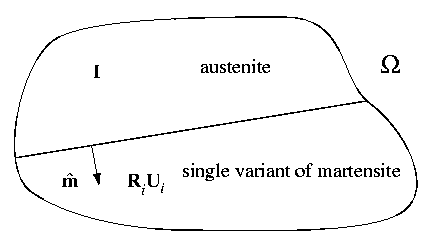Austenite Single Variant of Martensite Microstructure
At the critical temperature  , both of the phases can coexist in a specimen forming
an austenite martensite microstructure. The simplest
austenite martensite microstructure is a homogeneous region
of the austenite phase coexisting with a homogeneous region
of a single variant of the martensite phase. Such a deformation
is depicted in Figure 1 below.
, both of the phases can coexist in a specimen forming
an austenite martensite microstructure. The simplest
austenite martensite microstructure is a homogeneous region
of the austenite phase coexisting with a homogeneous region
of a single variant of the martensite phase. Such a deformation
is depicted in Figure 1 below.

Figure 1: Austenite single variant of
martensite microstructure
The compatibility equation for this microstructure with the
variant Ui can be written as

The unknowns in the equation above are the rotation
 , the shape
strain
, the shape
strain  , and the
habit plane normal
, and the
habit plane normal  .
Further, this equation is called the habit plane equation.
The shape strain gives the magnitude and sense of the
transformation; while, the habit plane is the interface
between the two phases. In general, the shape strain does not
lie in the habit plane, and therefore, the transformation involves
both shear and dilatation.
.
Further, this equation is called the habit plane equation.
The shape strain gives the magnitude and sense of the
transformation; while, the habit plane is the interface
between the two phases. In general, the shape strain does not
lie in the habit plane, and therefore, the transformation involves
both shear and dilatation.
Solutions exists to the habit plane equation if and only if the
matrix Ui has an eigenvalue less than one, an
eigenvalue equal to one, and an eigenvalue greater than one. This
requires special lattice parameters. In any event, at most two
solutions can exist to the habit plane equation.
In addition, if solutions exist to the habit plane equation, then
they can in general be divided into two sets of symmetry
related solutions. The number of solutions in each set is of
course the same as the number of martensite variants.
Some of the austenite single variant of martensite microstructures
which are possible for the different transitions as listed in the table
below.
In the table above, the first column is the transition; the
second lists the number of unique microstructures which can be
formed using all of the martensite variants; the third column
indicates if the microstructure is observed; and the last
column contains some comments.
Another austenite martensite microstructure has
twinned martensite and austenite coexisting.
Top of this page.
Back to the main page.
 , both of the phases can coexist in a specimen forming
an austenite martensite microstructure. The simplest
austenite martensite microstructure is a homogeneous region
of the austenite phase coexisting with a homogeneous region
of a single variant of the martensite phase. Such a deformation
is depicted in Figure 1 below.
, both of the phases can coexist in a specimen forming
an austenite martensite microstructure. The simplest
austenite martensite microstructure is a homogeneous region
of the austenite phase coexisting with a homogeneous region
of a single variant of the martensite phase. Such a deformation
is depicted in Figure 1 below.


 , the shape
strain
, the shape
strain  , and the
habit plane normal
, and the
habit plane normal  .
Further, this equation is called the habit plane equation.
The shape strain gives the magnitude and sense of the
transformation; while, the habit plane is the interface
between the two phases. In general, the shape strain does not
lie in the habit plane, and therefore, the transformation involves
both shear and dilatation.
.
Further, this equation is called the habit plane equation.
The shape strain gives the magnitude and sense of the
transformation; while, the habit plane is the interface
between the two phases. In general, the shape strain does not
lie in the habit plane, and therefore, the transformation involves
both shear and dilatation.
 =90 degrees,
trivial
=90 degrees,
trivial =1 only
=1 only =1
=1